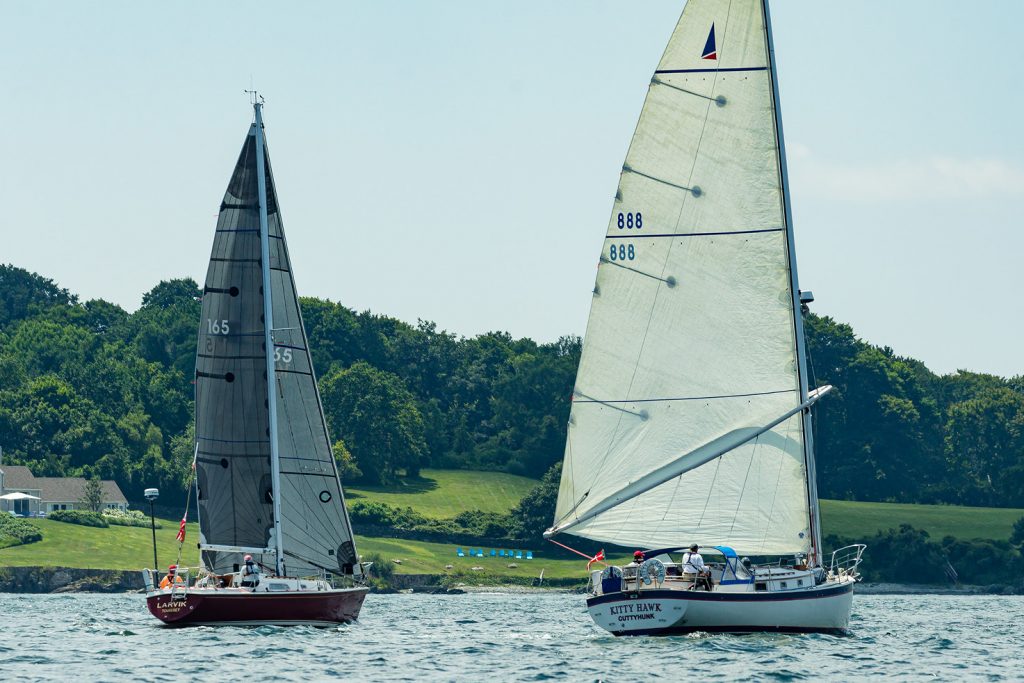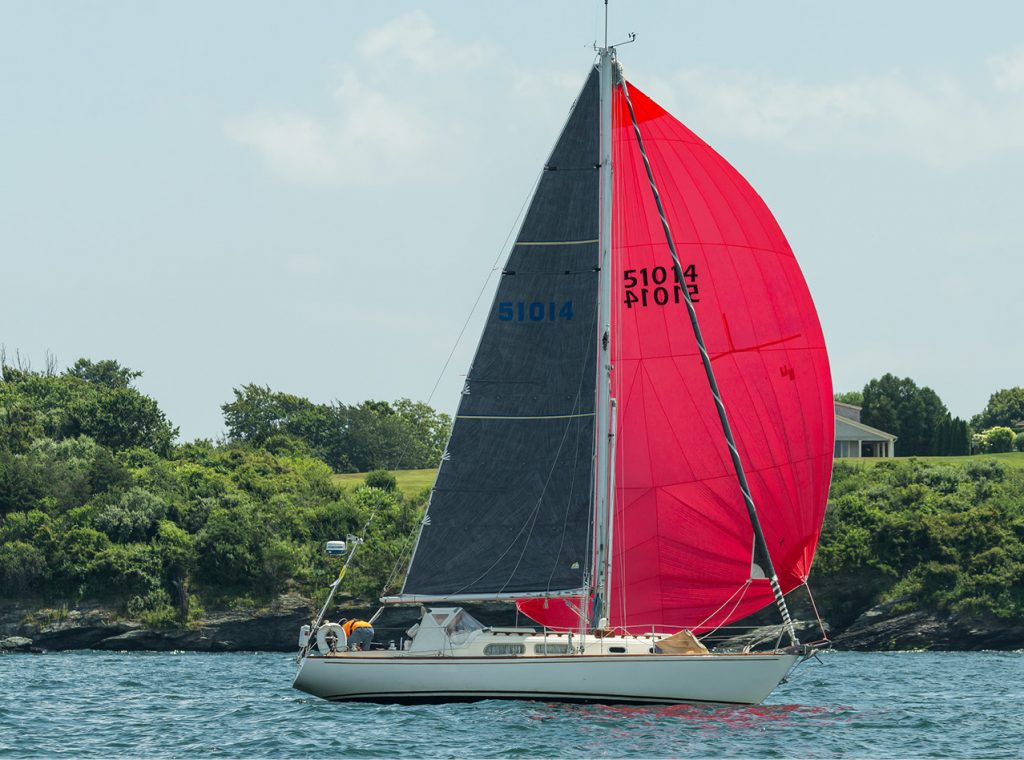
Monohull Cruising Canvas Twin competitors Larvik, a Pearson 10M sailed by Kim Anderson and William Beebe, and Kitty Hawk, a Nonsuch 33 sailed by John Corbishley and Winthrop Sanford, pass Hammersmith Farm. © Bill Shea Photography
The concept of racing doublehanded got a serious boost last year. This was driven, apart from “distancing” restrictions, by the proposal to include a doublehanded co-ed offshore class in the Olympics. Well, like many of the highly caffeinated drinks one might imbibe during the O’dark-thirty watch, this boost went up and came down pretty quickly, surrendering the field of DH racing back to the folks who have been doing it, in some cases, for years. Competitors in the New England Solo/Twin Championships come to mind.
First held in 1986 and organized today by Newport Yacht Club, the annual Solo/Twin has a variety of course lengths, offered for doublehanded and solo crews. One of the several interesting components of this race is the attraction it holds for people with “normal” boats. That is, not extreme offshore rockets. Yes, there are Class40s, Open 30s, sometimes Minis, and lately Kenny Read on a Jeanneau Sunfast 3300. The rest of the fleet exemplifies the cross section of production cruiser/racers likely to be seen at any marina, yacht club or mooring field in the country. Pick a manufacturer and on any given year they will be represented.
This year’s fleet of 32 boats in five classes faced the starter’s signals beginning at 1155 on Friday, 30 July. The 100-mile course took the fleet around the southwest corner of Block Island, over to a bell at the entrance to Vineyard Sound, back to Old Harbor at Block and thence to the finish off Castle Hill Light. The layout of the course and the prevailing and forecast winds from the northwest did not offer much in the way of great tactical and strategic decisions. Nonetheless, paying attention to boat speed and sail trim was the recipe for the gold on the day.
The puffy NW breeze kept crews on their toes as it shifted through 30-40 degrees and varied from 10 to 22 knots. Cooper’s 95/95 Theory (95% of max speed for 95% of the time) was the order of the day.
On the first leg to the bell off Block, all nine of the lead boats in Class One were bunched into a 15-minute window of rounding. Kenny, sailing with Suzy Leech, rounded a nice third, just six minutes behind a Class40 and a J/122.
Your correspondent was in Class 2 with Dr. Phil Haydon on Cepheus/Sail4Epilepsy, we rounded in company with, but just ahead of, half a dozen boats: another Quest 33, a Quest 30, a Farr 30, two J/99s and a J/109. The next leg, across to the “32” bell at the entrance to Vineyard Sound, was pedal down with the A2 kites. For the bulk of the time aboard Cepheus, this worked a treat. About 75% along the 35-mile leg, the breeze freshened to 20 knots and went ahead 25 degrees. This made the A2 most definitely NOT the sail of choice. It took us three pretty healthy, rail-underwater, tiller-in-your-teeth broaches for this to be knocked home. After we had run off and dropped the kite, we put the boat back into the new course for the mark and discovered that it was now a two-sail reach, the wind having continued to ahead us and not diminishing, plus we were further to leeward than 20 minutes prior. A few of the boats we had rounded in front of at Block did a better job of carrying smaller kites and rolled through under us, got further ahead, though more to leeward, finally dropped their kites and cruised up under our bow to round within a minute or so ahead of us.
Sailing another cracked reach, 45 or so apparent, into the setting sun, we were slowly reeling the Quest 30 and J/99 back towards us when they both took a big dive to leeward. Anticipating a header, we were poised to trim-on, but nothing happened, so we hung onto our course, with sheets eased, to the mark. We caught up to the Quest 30, but he came up to us from leeward and poked out in front of us to sneak around the make a bow sprint length in front of us. Net gain to us.
The next 30 to 40 minutes was where the sail trim aspect of this race really came home. We were literally bow-to-bow, and two- to four boat lengths apart in gage and working the puffs and lulls and shifts for all we were worth. Finally, we were able to get clear ahead and slowly roll down over the top of them. We beat them by about a minute but not by enough to save our time on them, so they corrected out on us taking second.

Richard McCally’s Pearson 33 Windswept (Monohull Spinnaker Solo) has completed nine Bermuda 1-2 races. © Bill Shea Photography
The first two classes were boats more focused on performance, and mostly in the short-handed realm. Class 40s, an Open 30, one of the foil-borne Figaro 30s, a modified Farr (Mumm) 30, and the new Jeanneau 3300, overall winner. The two “normal” boats, a J/122 and a J/133, were the outliers in Class 1, though the much-experienced Bob Manchester in his 133 Vamoose, took second behind Suzy and Kenny.
Class 2 was the unofficial Rodger Martin Memorial class, hosting four of his designs. Two Quest 30s and two 33s, with the 30s, the Original Quest line, taking one and two in class. Both boats are former Bermuda 1-2 winners; plus Phil and I in Cepheus/Sail 4 Epilepsy. Two of the new J/99s stretched their legs, though one still had the DH training wheels down and so was unspectacular.
Classes 3 and 4 had the bulk of the normal boats: an Archambault 31, a J/110, an Omega 42 (a past BDA 1-2 class winner) and a Pacer 310 Sprint (a fun little 30-footer like a Quest, but from South Africa). Class 4 was the “meat and potatoes” boats, with a Nonsuch 33 taking first, a Pearson 10 M second and an Express 35 third, plus a Catalina 36 and a C&C 33-2.
And in the singlehanded Class 5, a Tartan 4600 took first, a Pearson 33 (a nine-time BDA 1-2 competitor) second, and a Beneteau 40-7 third. A Hanse 420 rounded out the solo class. And remarking on the current discussion of gender inclusion, there were four women in the race among 27 souls, equal to 16%. A biscuit toss shy of the 18% in the last Vendée Globe.
A double-handed co-ed offshore Olympic event might’ve been interesting, but that ship seems to have sailed. It seems as though we’ll be stuck with the fifteen or so DH/Solo races in the Northeast for the foreseeable future. For more information, visit newportyachtclub.org/sailing/offshore/new-england-solo-twin/ ■



